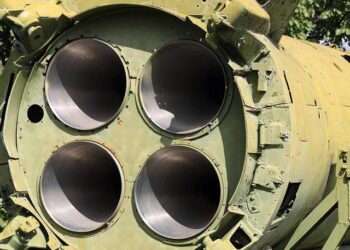Dispatch from the Russian Border: The Curonian Spit and the Contest of the Baltic Sea
Tensions simmer once again along the Baltic Sea as the contested region of the Curonian Spit emerges at the center of geopolitical rivalry between Russia and its Western neighbors. This slender strip of land, shared by Russia and Lithuania, has become more than just a natural wonder and UNESCO World Heritage site-it now symbolizes the broader strategic contest shaping the future of the Baltic region. In this dispatch, we examine how the Curonian Spit reflects the escalating security concerns, economic interests, and environmental challenges defining the Baltic Sea’s contested frontier, as detailed in an Atlantic Council analysis.
Tensions Rise Along the Curonian Spit Amidst Baltic Sea Strategic Contest
The Curonian Spit, a narrow strip of land separating the Curonian Lagoon from the Baltic Sea, has become a focal point of mounting geopolitical friction. As Russia bolsters its military installations along the border, NATO forces have increased surveillance and maritime patrols in the surrounding waters. This contest for control highlights the strategic value of the region, where control over sea lanes and airspace could prove decisive in any future Baltic confrontation. Local communities, meanwhile, find themselves caught in the crossfire of competing military interests, with civilian infrastructure facing growing restrictions and heightened security protocols.
Analysts emphasize the multifaceted nature of the tensions, noting both conventional military posturing and hybrid tactics aimed at solidifying influence. Key developments include:
- Expansion of anti-access/area denial (A2/AD) systems along coastal zones
- Increased airborne intelligence, surveillance, and reconnaissance (ISR) missions from Baltic allies
- Enhanced naval exercises with a focus on interoperability among NATO member states
- Implementation of new maritime traffic control measures restricting civilian and commercial vessel movement
| Aspect | Russian Activity | NATO Response |
|---|---|---|
| Military Installations | Upgraded coastal missile batteries | Increased naval patrols |
| Surveillance | Expanded radar coverage | Frequent ISR flights |
| Maritime Access | Restricted zones near the spit | Negotiations on freedom of navigation |
Assessing Russia’s Military Posture and Regional Implications for NATO
Along the eastern shores of the Baltic Sea, Russia’s military enhancements have increasingly drawn attention from NATO strategists. The deployment of advanced coastal missile systems and the modernization of air defense units in the Kaliningrad exclave have considerably shifted the regional balance of power. These capabilities enable rapid response along critical naval chokepoints, complicating NATO’s freedom of movement and surveillance operations. Moreover, the integration of layered electronic warfare assets within this theater underscores a distinct move towards asymmetric deterrence, designed to counter NATO’s conventional superiority without direct confrontation.
Key Regional Implications for NATO:
- Heightened surveillance demands along the Baltic Sea corridor, stretching NATO’s intelligence assets.
- Increased emphasis on rapid reinforcement and interoperability among Baltic member states.
- Potential vulnerability of maritime supply routes essential for NATO’s northern flank operations.
- Escalating naval presence from both sides fostering a continuous state of strategic alertness.
| Capability | Russian Deployment | NATO Countermeasures |
|---|---|---|
| Coastal Missile Systems | Bal and Bastion batteries | Enhanced naval patrols & aerial reconnaissance |
| Air Defense | S-400 Surface-to-Air Missiles | Integrated air defense networks & electronic countermeasures |
| Electronic Warfare | EW units embedded in Kaliningrad HQs | Signal intelligence upgrades & hardened communications |
Strengthening Baltic Security Cooperation to Deter Escalation and Ensure Stability
In response to the ongoing geopolitical tensions along the Russian border, Baltic nations have ramped up their collaborative defense initiatives aimed at deterring potential escalation. Recognizing the strategic significance of the Curonian Spit area – a narrow landform dividing the Baltic Sea – Estonia, Latvia, and Lithuania have intensified joint military exercises, intelligence sharing, and maritime patrols. This tri-national approach not only bolsters situational awareness but also sends a clear message of unity and readiness against any aggressive maneuvers that could threaten regional stability.
Key areas of focus include:
- Enhanced air and naval surveillance to monitor unusual activity.
- Integration of cyber defense capabilities to protect critical infrastructure.
- Expansion of rapid response forces stationed near potential flashpoints.
- Strengthening partnerships with NATO allies to increase deterrence.
| Capability | Current Status | Planned Enhancements |
|---|---|---|
| Maritime Patrols | Regular joint exercises | Increased frequency, drone integration |
| Air Surveillance | Shared radar networks | Real-time data fusion with NATO |
| Cybersecurity | National task forces | Regional coordination center |
To Conclude
As tensions continue to simmer along the Baltic Sea’s strategic frontier, the Curonian Spit remains a poignant symbol of the region’s contested geopolitics. This narrow strip of land, steeped in history and divided by shifting borders, underscores the broader struggle unfolding between Russia and NATO allies. Monitoring developments here is crucial for understanding the delicate balance of power in the Baltic, where every move carries implications far beyond the shoreline. The situation demands sustained attention from policymakers and analysts alike, as the contest over this vital corridor reflects the evolving dynamics of security and influence in Northern Europe.
















